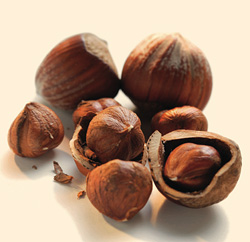
Linda Harris, UC Davis based food safety researcher writes:
The nut industry, lead by almonds in California, has been increasingly focused on microbial food safety issues over the past 10 years. Evidence-based good production and processing practices have been developed and are being adopted by the majority of nut growers and processors.
In March, 2011, hazelnuts grown in Oregon were linked to an E. coli O157:H7 outbreak that sickened at least eight people.
Food safety, public health and the well-being of customers should be the priority of any producer group. But a follow-up story on the outbreak this week by Oregon Public Broadcasting did little to serve public health.
Low moisture or dry foods like nuts have rarely been associated with outbreaks of foodborne illness until recently — in part because they weren’t detected in the past. Tools like PulseNet (which was developed in 1996 in response to the 1993 Jack-in-the-Box/E. coli O157:H7 outbreak) have resulted in the identification of several low-moisture food outbreaks, but almost all of them have been associated with salmonella. The hazelnut-E. coli O157:H7 link caught the attention of many in the food safety world.
The evidence linking hazelnuts wasn’t perfect but was strong. The most complete outbreak evidence links human cases with isolates that have matching genetic fingerprints to identical isolates from unopened packages of the same lot of product that the cases consumed. According to CDC, the eight illnesses in three states were initially linked to inshell hazelnuts through epidemiology. Three different labs in three different states (Minnesota, Wisconsin and California) isolated the matching strain from open bags of inshell hazelnuts or mixed nuts containing hazelnuts. Not perfect, but strong evidence that hazelnuts were indeed the cause of this outbreak.
There is short window of time to investigate the root causes of an outbreak. The hazelnuts involved in the outbreak would have been harvested in September or October last year and inspecting the farms that supplied those nuts may have yielded little information. However, when George Packaging, the distributor, declined to offer the U.S. Food and Drug Administration a list of the farms that provided the hazelnuts, the investigation was stalled.
In 2001, my staff and I started to study almond orchards after consumption of raw almonds was linked to an outbreak of salmonellosis. A rare type of salmonella was recovered from human cases, unopened boxes of almonds, the processing facility and orchards. Even though it was months after the almonds were harvested, FDA and California Department of Public Health were able to trace the salmonella back to the specific outbreak orchards where a follow-up investigation ensued. While that investigation never definitively pinpointed the exact cause of the outbreak the research did generate data the almond industry needed to develop and apply scientifically-backed food safety programs.
Larry George, the owner of George Packaging and a state senator, said it’s no surprise there’s E. coli on nuts coming from farms. He says deer wander through orchards and poop, birds fly over and poop. He says the FDA is also encouraging farmers to use more manure for fertilizer — instead of chemicals.
The FDA does not encourage growers to apply raw manure to crops, especially crops that are consumed without a validated kill step – something to eliminate the poop. Properly composted manure is, however, recognized as a valuable soil amendment. Like many other nuts, hazelnuts are harvested by shaking them to the ground and sweeping them up; orchard floor management is definitely important.
I spoke about food safety to the hazelnut industry in Oregon in May 2010, and one of the identified next steps was to adapt the Oregon State good agricultural practices (GAPs) program to hazelnut production and harvest. This has been done and is great start; it can be added to a growing list of resources for the nut industry at: http://ucfoodsafety.ucdavis.edu/Nuts,_Legumes,_and_Seeds/
Full implementation of GAPs throughout the hazelnut industry is the next step.
Hazelnut packers should also identify control steps that could be used reduce pathogens on the nuts after harvest. With a salmonella-linked recall for hazelnuts in Dec. 2009 and this recent E. coli O157:H7 outbreak, hazelnuts have at least two microbial hazards to focus on. Washing with chlorine or citrus might help but these steps should be scientifically validated to demonstrate they actually work.
In response to outbreaks of salmonellosis, the Grocery Manufacturer’s Association (GMA) coordinated the development of an Industry Handbook for Safe Processing of Nuts, which is also a good place to start, but the key is to implement effective and verifiable actions.
Growers and processors of food have a responsibility to provide safe food. When I spoke about this last May to a full house for a day and a half, I indicated that hazelnut growers were rather lucky — at that time they had a single recall with no associated illnesses, and nine years research and development in other nuts to draw upon. Unfortunately, luck and time run out with a documented outbreak, and it is just four months till the 2011 hazelnut harvest begins.
—
Linda Harris is a specialist in Cooperative Extension in the Department of Food Science and Technology, is an associate director at the UC Davis Western Institute for Food Safety and Security (WIFSS) and the Western Center for Food Safety. Her research on food safety issues of importance to the fruit, vegetable, and nut industries has been used to guide growers, the food industry, and consumers in safer handling and preparation methods for these products. Some of Linda’s almond work can be found here and here.
